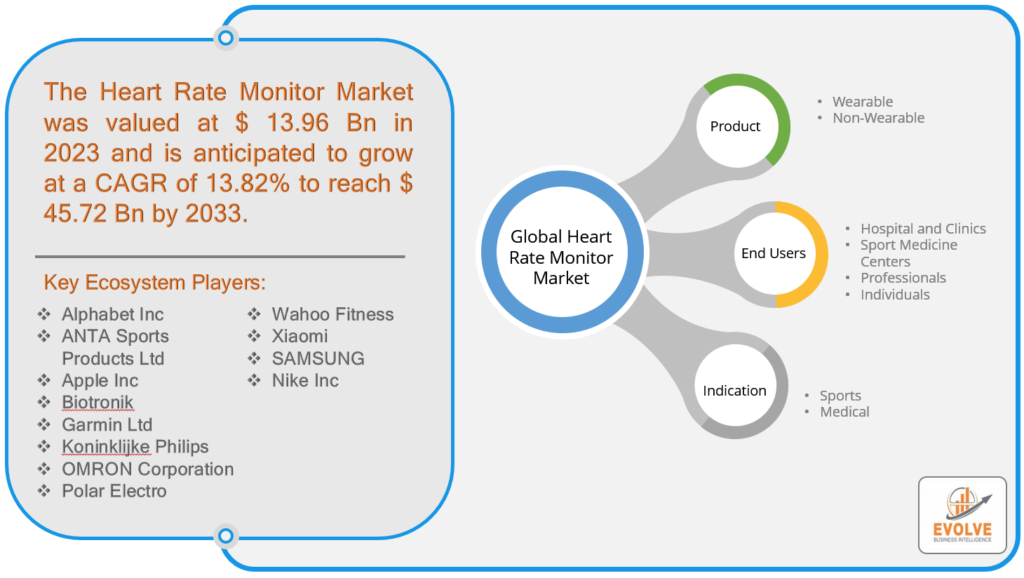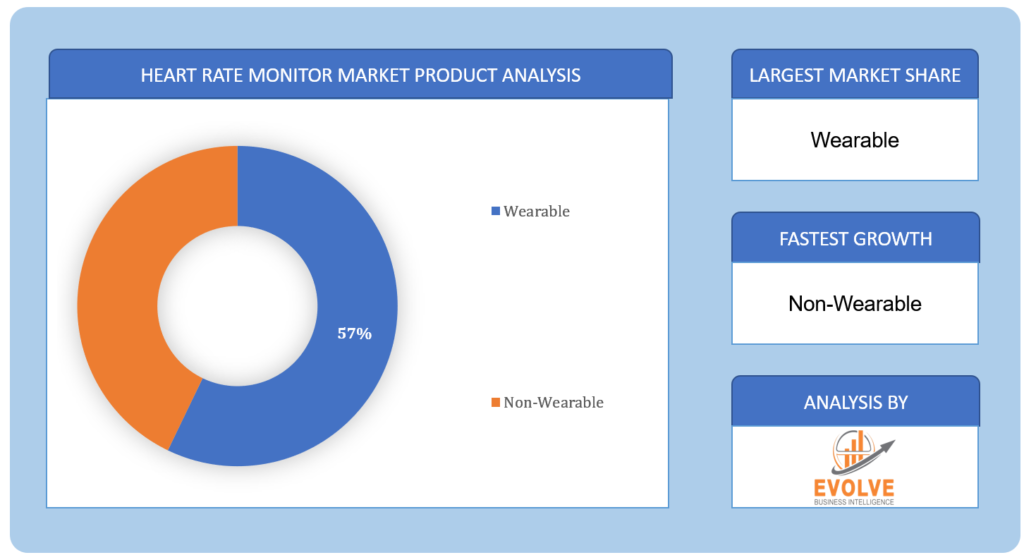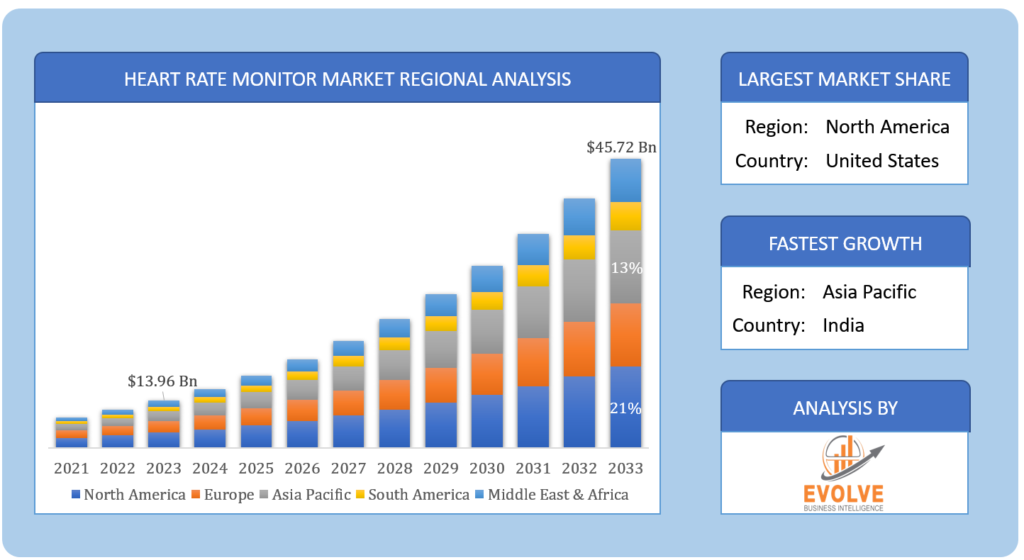Global Heart Rate Monitor Market Size is expected to reach USD 45.72 Billion by 2033. The global Heart Rate Monitor industry size accounted for USD 13.96 billion in 2023 and is expected to expand at a compound annual growth rate (CAGR) of 13.82% from 2023 to 2033. A heart rate monitor is a device or technology used to measure and display a person’s heart rate in real time. It typically consists of a sensor that detects the electrical activity of the heart, such as an electrocardiogram (ECG or EKG), or a sensor that measures the blood flow or pulse, such as a photoplethysmography (PPG) sensor. The heart rate monitor may be integrated into various devices, such as fitness trackers, smartwatches, chest straps, or handheld devices. Heart rate monitors provide valuable information about a person’s cardiovascular health and fitness levels. They are commonly used during exercise or physical activities to monitor the intensity of workouts, track performance, and optimize training. Heart rate monitors can also be used in medical settings to monitor patients with heart conditions or during stress tests, and by individuals who want to monitor their heart rate for health or wellness purposes.
The impact of the COVID-19 pandemic on the heart rate monitor market has been mixed, with both positive and negative effects. While there have been some positive aspects, such as increased awareness of health and fitness, higher demand for home-based fitness equipment, and a focus on monitoring personal health, there have also been negative impacts on the market due to the pandemic, such as disruptions in the supply chain, decreased consumer spending, and challenges in manufacturing and distribution.
Heart Rate Monitor Market Dynamics
The major factors that have impacted the growth of Heart Rate Monitor are as follows:
Drivers:
Increasing Emphasis on Health and Fitness
The increasing emphasis on health and fitness is one of the key drivers of the market. As people become more health-conscious and prioritize physical fitness, there is a growing demand for tools and devices that can help monitor and optimize their health and fitness activities, including heart rate monitors. Heart rate monitors are widely used by athletes, fitness enthusiasts, and individuals engaging in various physical activities to track their heart rate in real time and optimize their training or exercise routines. Regular monitoring of heart rate during exercise can provide insights into the effectiveness of workouts, help individuals maintain target heart rate zones, and prevent overexertion or injury. As people become more aware of the benefits of monitoring their heart rate during exercise and other physical activities, the demand for heart rate monitors is expected to continue to grow. Additionally, heart rate monitors are also being used by individuals with certain medical conditions, such as cardiovascular diseases or conditions requiring cardiac rehabilitation, further driving the market demand.
Restraint:
- Privacy and Data Security Concerns
Heart rate monitors, like many other health monitoring devices, may collect and store sensitive personal health data. Privacy and data security concerns related to the collection, storage, and usage of personal health data may impact the adoption of heart rate monitors, particularly among privacy-conscious consumers who are concerned about the potential misuse or unauthorized access to their health data.
Opportunity:
Increasing Adoption of Wearable Devices
Wearable devices, including heart rate monitors, are gaining popularity among consumers for tracking various health and fitness parameters. The growing adoption of wearables, such as smartwatches, fitness bands, and chest straps, presents an opportunity for heart rate monitor manufacturers to cater to the increasing demand for integrated health monitoring solutions. There is an opportunity to develop heart rate monitors that are compatible with various wearable devices, providing seamless integration and enhanced user experience.
Heart Rate Monitor Segment Overview
Based on the Product, the market is segmented based on Wearable and Non-Wearable. During the projection period, the Wearable segment is expected to hold the largest market share. Wearable heart rates monitors, such as fitness trackers, smartwatches, chest straps, and armbands, are popular among consumers for tracking heart rate data during various activities, including sports, fitness, and everyday activities. There is a rising awareness of the importance of health and fitness, and consumers are increasingly adopting wearable heart rate monitors as a convenient and accessible way to monitor their heart rate during workouts, optimize training, and track overall cardiovascular health.
By End Users
Based on End Users, the market has been divided into hospitals and Clinics, Sports Medicine Centers, Professionals, and Individuals. The Sports Medicine Centers segment is expected to hold the largest market share. Heart rate monitors may be used in sports medicine centers for monitoring patients’ heart rates during rehabilitation or exercise therapy, it is not a primary market segment for heart rate monitors.
By Indication
Based on Indication, the market has been divided into Sports and Medical. The Sports segment is expected to hold the largest market share. There is a growing awareness of the importance of health and fitness among individuals globally. Heart rate monitors are used to track heart rate data during workouts, providing insights on training intensity, recovery, and overall cardiovascular health, making them popular among health-conscious consumers.
Global Heart Rate Monitor Market Share, by Segmentation
 Global Heart Rate Monitor Market Regional Analysis
Global Heart Rate Monitor Market Regional Analysis
Based on region, the global MHealth market has been divided into North America, Europe, Asia-Pacific, and the Rest of the World. North America is projected to dominate the use of the market followed by the Asia-Pacific and Europe regions.
North America Market
North America is expected to dominate the market due to factors such as a culture that emphasizes health and fitness, a high prevalence of cardiovascular diseases, a strong demand for fitness and health monitoring devices, and North America is known for its technological advancements and innovations in the healthcare and fitness industries, including heart rate monitoring technologies. This has led to the development of advanced heart rate monitors with features such as wireless connectivity, GPS tracking, and advanced analytics, which further drive the demand for heart rate monitors in the region.
Asia-Pacific Market
The Asia-Pacific region is projected to be a prominent growth market for Heart Rate monitoring in the coming years. There is a growing awareness of the importance of health and fitness in the APAC region, with a rising middle class and increasing disposable incomes. As a result, more individuals are engaging in regular exercise and physical activities, leading to an increased demand for heart rate monitors as a tool for tracking and optimizing workouts. Rapid urbanization and lifestyle changes have led to an increase in lifestyle-related health conditions, such as cardiovascular diseases, in the APAC region. Heart rate monitors can be used for preventive health management, allowing users to monitor their heart rate and detect any abnormalities or potential risks related to cardiovascular health.
Competitive Landscape
The market comprises tier-1, tier-2, and local players. With their wide product portfolios, tier-1 and tier-2 players have a global reach. Since of their strategic innovations and broad regional presence, companies such as Garmin Ltd, Koninklijke Philips, OMRON Corporation, and Polar Electro lead the global Heart Rate Monitor business. To increase their market position and attract a wide consumer base, the businesses are employing various strategies, such as growth, product releases, and alliances.
Prominent Players:
- Alphabet Inc
- ANTA Sports Products Ltd
- Apple Inc
- Biotronik
- Garmin Ltd
- Koninklijke Philips
- OMRON Corporation
- Polar Electro
- Wahoo Fitness
- Xiaomi
- SAMSUNG
- Nike Inc
Key Development:
January 2023: Philips and Masimo to collaborate on remote patient monitoring by launching new W1 wearable. The watch monitors respiration rate, oxygen saturation, pulse rate, and, in a limited release, hydration level.
December 2022: Garmin introduced a new heart-rate monitor, bottle cages made of stainless steel, and a Supersapiens blood glucose monitoring kit.
Scope of the Report
Global Heart Rate Monitor Market, by Product
- Wearable
- Non-Wearable
Global Heart Rate Monitor Market, by End Users
- Hospital and Clinics
- Sports Medicine Centers
- Professionals
- Individuals
Global Heart Rate Monitor Market, by Indication
- Sports
- Medical
Global Heart Rate Monitor Market, by Region
- North America
- US
- Canada
- Mexico
- Europe
- UK
- Germany
- France
- Italy
- Spain
- Benelux
- Nordic
- Rest of Europe
- Asia Pacific
- China
- Japan
- South Korea
- Indonesia
- Austalia
- Malaysia
- India
- Rest of Asia Pacific
- South America
- Brazil
- Argentina
- Rest of South America
- Middle East & Africa
- Saudi Arabia
- UAE
- Egypt
- South Africa
- Rest of Middle East & Africa
| Parameters | Indicators |
|---|---|
| Market Size | 2033: $45.72 Billion |
| CAGR | 13.82% CAGR (2023-2033) |
| Base year | 2022 |
| Forecast Period | 2023-2033 |
| Historical Data | 2021 |
| Report Coverage | Revenue Forecast, Competitive Landscape, Growth Factors, and Trends |
| Key Segmentations | Product, End Users, Indication |
| Geographies Covered | North America, Europe, Asia-Pacific, Latin America, Middle East, Africa |
| Key Vendors | Alphabet Inc, ANTA Sports Products Ltd, Apple Inc, Biotronik, Garmin Ltd, Koninklijke Philips, OMRON Corporation, Polar Electro, Wahoo Fitness, Xiaomi, SAMSUNG, Nike Inc |
| Key Market Opportunities | Increasing Adoption of Wearable Devices |
| Key Market Drivers | Increasing Emphasis on Health and Fitness |
REPORT CONTENT BRIEF:
- High-level analysis of the current and future Heart Rate Monitor market trends and opportunities
- Detailed analysis of current market drivers, restraining factors, and opportunities in the future
- Heart Rate Monitor market historical market size for the year 2021, and forecast from 2023 to 2033
- Heart Rate Monitor market share analysis at each product level
- Competitor analysis with a detailed insight into its product segment, financial strength, and strategies adopted.
- Identifies key strategies adopted including product launches and developments, mergers and acquisitions, joint ventures, collaborations, and partnerships as well as funding taken and investment done, among others.
- To identify and understand the various factors involved in the global Heart Rate Monitor market affected by the pandemic
- To provide a detailed insight into the major companies operating in the market. The profiling will include the financial health of the company’s past 2-3 years with segmental and regional revenue breakup, product offering, recent developments, SWOT analysis, and key strategies.








